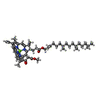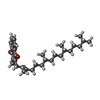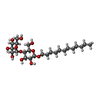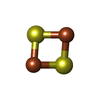+Search query
-Structure paper
| Title | Structure of a photosystem I-ferredoxin complex from a marine cyanobacterium provides insights into far-red light photoacclimation. |
|---|---|
| Journal, issue, pages | J Biol Chem, Vol. 298, Issue 1, Page 101408, Year 2022 |
| Publish date | Nov 15, 2021 |
 Authors Authors | Christopher J Gisriel / David A Flesher / Gaozhong Shen / Jimin Wang / Ming-Yang Ho / Gary W Brudvig / Donald A Bryant /   |
| PubMed Abstract | Far-red light photoacclimation exhibited by some cyanobacteria allows these organisms to use the far-red region of the solar spectrum (700-800 nm) for photosynthesis. Part of this process includes ...Far-red light photoacclimation exhibited by some cyanobacteria allows these organisms to use the far-red region of the solar spectrum (700-800 nm) for photosynthesis. Part of this process includes the replacement of six photosystem I (PSI) subunits with isoforms that confer the binding of chlorophyll (Chl) f molecules that absorb far-red light (FRL). However, the exact sites at which Chl f molecules are bound are still challenging to determine. To aid in the identification of Chl f-binding sites, we solved the cryo-EM structure of PSI from far-red light-acclimated cells of the cyanobacterium Synechococcus sp. PCC 7335. We identified six sites that bind Chl f with high specificity and three additional sites that are likely to bind Chl f at lower specificity. All of these binding sites are in the core-antenna regions of PSI, and Chl f was not observed among the electron transfer cofactors. This structural analysis also reveals both conserved and nonconserved Chl f-binding sites, the latter of which exemplify the diversity in FRL-PSI among species. We found that the FRL-PSI structure also contains a bound soluble ferredoxin, PetF1, at low occupancy, which suggests that ferredoxin binds less transiently than expected according to the canonical view of ferredoxin-binding to facilitate electron transfer. We suggest that this may result from structural changes in FRL-PSI that occur specifically during FRL photoacclimation. |
 External links External links |  J Biol Chem / J Biol Chem /  PubMed:34793839 / PubMed:34793839 /  PubMed Central PubMed Central |
| Methods | EM (single particle) |
| Resolution | 2.91 Å |
| Structure data | EMDB-24821, PDB-7s3d: |
| Chemicals |  ChemComp-CL0:  ChemComp-CLA: 
ChemComp-F6C:  ChemComp-PQN:  ChemComp-SF4:  ChemComp-BCR:  ChemComp-LHG:  ChemComp-LMG:  ChemComp-LMT:  ChemComp-CL:  ChemComp-CA:  ChemComp-FES:  ChemComp-HOH: |
| Source |
|
 Keywords Keywords | PHOTOSYNTHESIS / Photosystem I / Far-red light photoacclimation / Chlorophyll f / Ferredoxin / PsaF / PsaJ |
 Movie
Movie Controller
Controller Structure viewers
Structure viewers About Yorodumi Papers
About Yorodumi Papers





 synechococcus sp. pcc 7335 (bacteria)
synechococcus sp. pcc 7335 (bacteria)